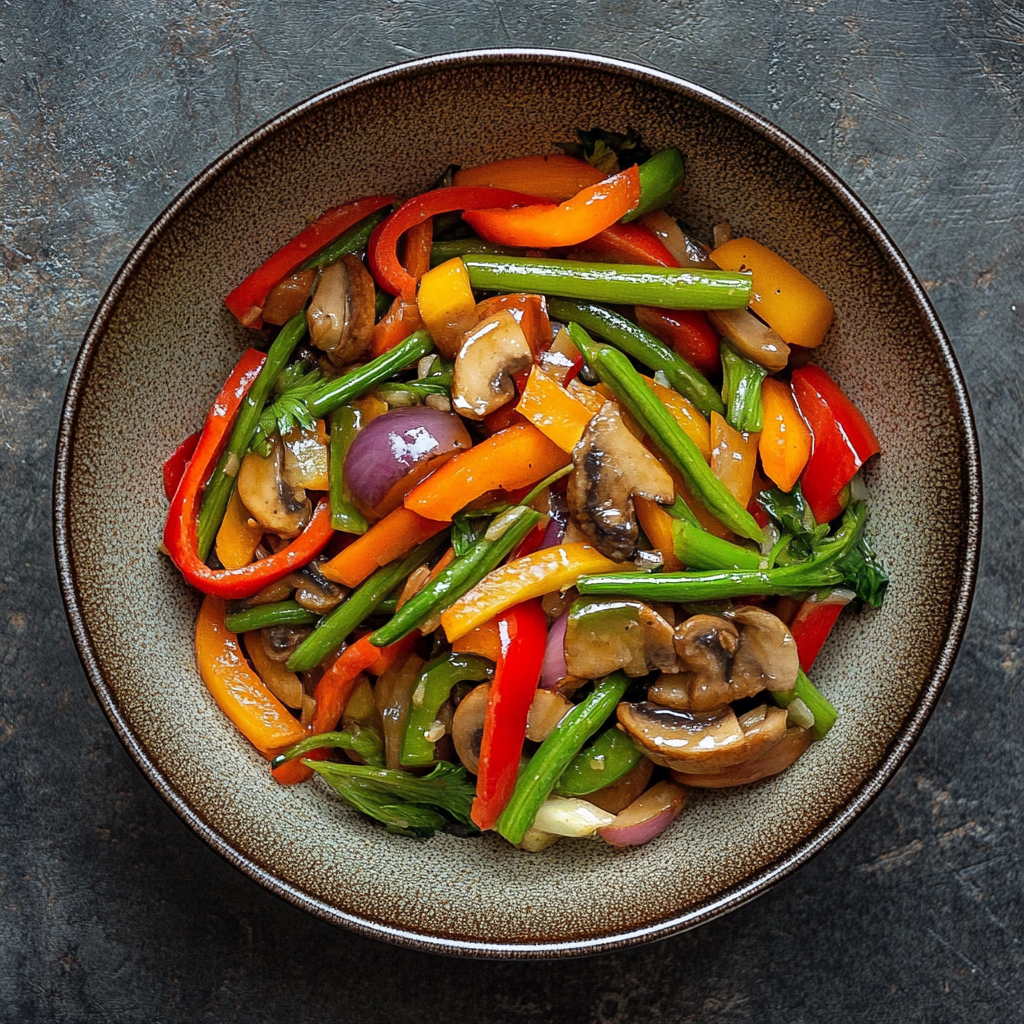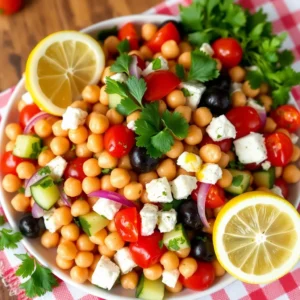There’s something magical about the sizzle of fresh vegetables hitting a hot pan. That sound—along with the aromatic blend of garlic and ginger wafting through the kitchen—signals that something delicious is minutes away from your table. If you’re like me, constantly juggling work deadlines, family obligations, and the eternal question of “what’s for dinner?”, then this Vegetable Stir Fry recipe might just become your new best friend.
Hi there! Alexandre here from the FoodyTasty kitchen, where I believe that even the busiest weeknights deserve a meal that’s both nourishing and delightful. Today, I’m sharing one of my absolute favorite go-to recipes when time is short but I refuse to compromise on flavor or nutrition.
Why You’ll Love This Vegetable Stir Fry
Let’s be honest—we all have those nights when ordering takeout seems like the only option. The fridge is filled with random vegetables that are on the brink of being forgotten, and your energy tank is running on empty. This Vegetable Stir Fry is my answer to those nights, and here’s why it might become yours too:
- It’s lightning-fast: From prep to plate in just 20 minutes—faster than delivery!
- It’s incredibly versatile: Use whatever vegetables you have on hand—no special shopping trip required.
- It’s a nutritional powerhouse: Packed with vitamins, minerals, and fiber that will actually make you feel good.
- It’s budget-friendly: Way cheaper than takeout and helps reduce food waste by using up those veggies hiding in your crisper drawer.
But most importantly? It’s absolutely delicious. The vegetables maintain their beautiful colors and perfect crunch, while the sauce—oh, that sauce!—brings everything together with its perfect balance of savory, sweet, and tangy notes.
What Makes a Great Vegetable Stir Fry?
The beauty of a stir fry lies in its simplicity. But don’t be fooled—behind that simplicity are a few key principles that transform ordinary vegetables into an extraordinary meal:
Fresh vegetables: The star players here should be vibrant, crisp, and full of life. Sad, wilted veggies need not apply (though slightly past-prime ones can still find redemption here!).
High heat and quick cooking: This is what gives stir fry its distinctive texture—vegetables that are tender yet still have a satisfying bite.
A balanced sauce: The magic elixir that ties everything together, delivering layers of flavor in every bite.
The right sequence: Adding ingredients in the proper order ensures everything is perfectly cooked—nothing mushy, nothing raw.
Master these elements, and you’ll never look at those random vegetables in your fridge the same way again!
Ingredients You’ll Need
For this recipe, I’ve chosen a rainbow of vegetables that work beautifully together, but remember—this is your canvas! Feel free to swap based on what you have available or what your family loves.
For the vegetables:
- 2 tablespoons olive oil
- 1 large onion, thinly sliced
- 1 bell pepper (any color), thinly sliced
- 1 medium zucchini, sliced into half-moons
- 1 cup broccoli florets
- 1/2 cup carrots, julienned
- 1/2 cup snap peas, trimmed
For the sauce:
- 2 garlic cloves, minced
- 2 tablespoons soy sauce
- 1 tablespoon sesame oil
- 1 tablespoon rice vinegar
- 1 tablespoon honey
- 1 teaspoon fresh ginger, grated
- 1 teaspoon sesame seeds (optional, for garnish)
How to Make the Perfect Vegetable Stir Fry
Step 1: Prep Your Vegetables
The most time-consuming part of making a stir fry is actually the prep work. Once you start cooking, things move fast! That’s why professional chefs always emphasize “mise en place”—having everything in its place before you begin.
- Slice your onion into thin, even pieces
- Cut your bell pepper into strips
- Slice the zucchini into half-moons about 1/4 inch thick
- Cut broccoli into bite-sized florets
- Julienne or thinly slice your carrots
- Trim the ends of your snap peas
Quick tip: Try to cut everything into similar sizes so they cook at the same rate. And if you’re really pressed for time, many grocery stores offer pre-cut stir fry vegetables that work perfectly here!
Step 2: Mix Your Sauce
While your wok or pan is heating up, quickly whisk together your sauce ingredients:
In a small bowl, combine the soy sauce, sesame oil, rice vinegar, honey, and grated ginger. Mix until the honey is fully dissolved. Set aside.
Time-saving tip: You can make a larger batch of this sauce and store it in the refrigerator for up to a week. Just give it a good shake before using, and your future self will thank you!
Step 3: Get Stir-Frying!
Now comes the fun part—the actual cooking! Here’s where that beautiful sizzle happens:
- Heat your olive oil in a large pan or wok over medium-high heat until it’s shimmering but not smoking.
- Add the onions first and sauté for 2-3 minutes until they start to become translucent.
- Toss in the harder vegetables—broccoli, carrots, and bell peppers. Stir-fry for about 4-5 minutes, keeping everything moving.
- Add the zucchini and snap peas. These are more delicate and need less cooking time—about 2-3 minutes.
- Add the minced garlic and stir for just 30 seconds until fragrant. (Adding it too early can cause it to burn and turn bitter.)
- Pour in your prepared sauce, tossing everything to ensure each veggie gets a nice coating.
- Cook for another 1-2 minutes until the sauce slightly thickens and clings to the vegetables.
- Sprinkle with sesame seeds if using.
The entire cooking process should take less than 15 minutes, and that’s if you’re taking your time!
Step 4: Serve and Enjoy!
This Vegetable Stir Fry is delicious on its own, but it also pairs beautifully with:
- Steamed rice (white or brown)
- Quinoa for extra protein
- Noodles (rice noodles, udon, or even spaghetti in a pinch!)
Want to make it a more substantial meal? Add a protein like:
- Cubed tofu (add it with the harder vegetables)
- Sliced chicken (cook it first, remove, then add back at the end)
- Shrimp (add them just before the softer vegetables)
The Secret to Stir Fry Success
The biggest mistake people make with stir fry? Overcrowding the pan! When you pile too many vegetables into your pan, they steam rather than sear, resulting in soggy vegetables instead of that perfect crisp-tender texture we’re after.
If you’re cooking for a family, consider doing your stir fry in batches. Yes, it takes a bit more time, but the improved texture and flavor are absolutely worth it. Alternatively, use the biggest pan you’ve got—a 12-inch skillet at minimum, or better yet, a wok designed specifically for this purpose.
Game-Changing Stir Fry Tips From My Kitchen to Yours
After years of making this Vegetable Stir Fry (and occasionally messing it up!), I’ve collected some invaluable tips that will elevate your stir fry game:
Heat your pan before adding oil. This prevents the vegetables from absorbing too much oil and becoming greasy. When the pan is hot, add your oil, swirl it around, and then immediately add your first ingredients.
Keep things moving. The word “stir” is in the name for a reason! Use a wooden spoon or a wok spatula to keep everything in constant motion. Got a stuck carrot piece? No worries—just call it “caramelized” and move on!
Add aromatics at the right time. Garlic and ginger burn easily, which can leave your dish with a bitter taste. Add them toward the end of cooking for just enough time to become fragrant without burning.
Don’t be afraid to deglaize. Those browned bits stuck to the bottom of your pan? That’s pure flavor! If things are sticking a bit, add a tablespoon of water or vegetable broth to loosen them up and incorporate that goodness back into your stir fry.
Taste and adjust before serving. Every vegetable has different levels of natural sweetness. Sometimes you might need an extra splash of soy sauce or a drizzle of honey to balance the flavors perfectly. Trust your taste buds!
Got a sauce that won’t thicken? Mix 1 teaspoon of cornstarch with 1 tablespoon of cold water and stir it into your sauce during the last minute of cooking. Magic!
The Day My Vegetable Stir Fry Saved Dinner
Last Tuesday was one of those days when everything that could go wrong, did. My grocery delivery was delayed, my laptop decided to update itself in the middle of an important document, and my daughter chose that precise moment to inform me she needed cupcakes for school—the next morning.
By 6:30 PM, I was staring blankly into my refrigerator, wondering if cereal could count as dinner (again). Then I spotted a slightly wrinkled bell pepper, half an onion, and a few other vegetable odds and ends. Twenty minutes later, we were sitting down to this Vegetable Stir Fry, and my 10-year-old—who normally negotiates each vegetable bite like a seasoned diplomat—asked for seconds.
That’s the beauty of this dish. It transforms the ordinary into something special, and it’s forgiving enough that even on your worst days, it still turns out delicious. It’s not just a recipe—it’s kitchen therapy.
Your Burning Stir Fry Questions, Answered
Can I make Vegetable Stir Fry ahead of time?
Absolutely! While stir fry is best enjoyed fresh off the wok, it makes excellent meal prep for busy weeks. The key is to slightly undercook your vegetables since they’ll continue cooking when you reheat them. Store in airtight containers in the refrigerator for up to 3 days. When reheating, a quick minute or two in a hot pan works better than the microwave to maintain that fresh stir fry texture.
What vegetables work best for stir fry?
The beauty of stir fry is that almost any vegetable can shine! For the best quick meal experience, combine vegetables with similar cooking times, or add them in stages. Vegetables that work particularly well include bell peppers, broccoli, carrots, snap peas, zucchini, mushrooms, and bok choy. If you’re using vegetables that release a lot of water (like mushrooms or spinach), cook them separately and add them at the end to prevent your stir fry from becoming soggy.
How can I make my stir fry sauce more interesting?
The basic stir fry sauce I’ve shared is versatile, but feel free to experiment! For a spicy kick, add sriracha or red pepper flakes. For a more complex flavor, try a tablespoon of hoisin or oyster sauce. Love citrus? A squeeze of lime juice at the end brightens everything up. You can even swap the honey for maple syrup or brown sugar for a slightly different sweetness profile. Healthy eating never has to be boring!
Beyond the Basic Vegetable Stir Fry
Once you’ve mastered this basic recipe, the stir fry world is your oyster! Here are some variations to keep things interesting:
Thai-Inspired: Add a tablespoon of peanut butter to your sauce, use lime instead of rice vinegar, and finish with fresh cilantro and crushed peanuts.
Chinese Takeout Style: Add a bit more honey to your sauce, along with a tablespoon of ketchup (trust me!) for that sweet and sour flavor we all secretly love.
Mediterranean Twist: Skip the soy sauce and sesame oil. Instead, use olive oil for cooking, and finish with a splash of balsamic vinegar, fresh basil, and a sprinkle of feta cheese.
Breakfast Stir Fry: Yes, stir fry for breakfast! Use your leftover Vegetable Stir Fry as the base for a breakfast bowl, topped with a fried egg. The runny yolk creates an incredible sauce that takes this dish to a whole new level.
Perfect Pairings for Your Vegetable Stir Fry
While this dish stands beautifully on its own, here are some suggestions to round out your meal:
For extra protein: Serve alongside my Honey Garlic Chicken Thighs for a complete meal that’s still on the table in under 30 minutes.
For a light starter: Begin with a simple Cucumber Salad that refreshes the palate before the main event.
For a cozy night in: Complete your takeout-inspired feast with Homemade Egg Rolls that are easier to make than you might think!
Need more guidance on cooking vegetables perfectly? Check out this helpful vegetable cooking guide from Serious Eats, or learn about the nutritional benefits of stir-frying versus other cooking methods from Healthline.
The Vegetable Stir Fry: A Love Letter to Busy Cooks
As we wrap up this culinary journey, I want to leave you with a thought: cooking doesn’t have to be complicated to be incredible. This Vegetable Stir Fry is proof of that. With just a handful of ingredients, a bit of heat, and about 20 minutes of your time, you can create something that nourishes both body and soul.
In my kitchen—and hopefully now in yours—this recipe represents more than just dinner. It’s a reminder that we can find moments of creativity and joy even in the midst of our busiest days. It’s permission to improvise with what you have rather than stressing about what you don’t. And most importantly, it’s an invitation to gather around the table, even briefly, to share a meal that was made with care.
So the next time you find yourself staring into the refrigerator at 6 PM, wondering what on earth you’re going to make for dinner, remember this Vegetable Stir Fry. Those random vegetables aren’t just ingredients—they’re the building blocks of your next delicious meal.
From my kitchen to yours, bon appétit!



